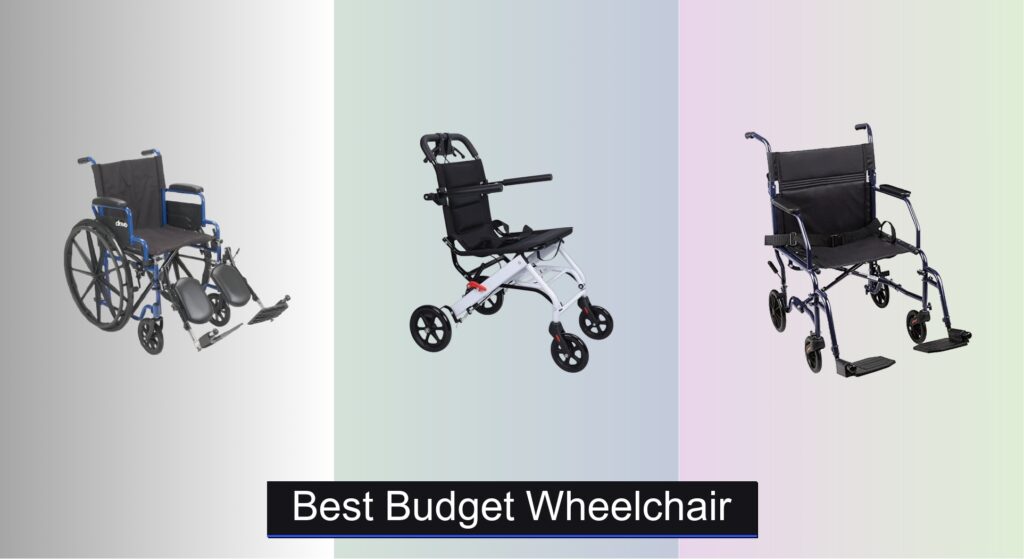Finding an affordable wheelchair that doesn’t sacrifice safety or functionality can be a challenge. Many budget options compromise on weight capacity, durability, or ease of transport, leaving users with uncomfortable or unreliable mobility solutions. Factors like portability, proper fit, and reliable brakes are critical, especially for daily use or travel.
We analyzed over 50 models, comparing key specs, user reviews, and value scores to identify the best budget wheelchair that balances cost, comfort, and reliability. Our picks prioritize essential features like weight capacity, lightweight frames, and smooth folding mechanisms—ensuring you get dependable performance without overspending. Below are our top-rated options for every need and budget.
Best Options at a Glance


Saterkali Ultra-Lightweight 13.66lbs Wheelchair
Best Lightweight
- 13.66lbs
- 180lbs
- Aluminum Alloy
- 1-second collapse
- Polyurethane with 360° casters

Carex 19 Inch Seat Transport Chair
Best Budget Friendly
- 25 lbs
- 19 inch
- Steel
- Yes
- Adjustable

Drive TR37E-SV Lightweight Folding Chair
Best Value Under $80
- 250 lbs
- 17″ or 19″
- Steel
- 8 inch
- 8 inches

Medline 26 lb. Transport Wheelchair
Best Mid-Range Comfort
- 26 lb.
- 300 lb.
- 19″ x 16″
- 12″ rear
- Handbrakes, locking

EconoHome 22 lbs Lightweight Wheelchair
Best Aluminum Frame
- 22 lbs
- 300 lb
- Aluminum
- Hand brakes
- Fully Assembled

Medline 20″W Comfort Folding Chair
Best Wide Seat Comfort
- 20″W x 16″D
- 300 lb
- 38 lbs
- Folding
- Swing-Back
Best Budget Wheelchair Review
Choosing the Right Wheelchair: A Buyer’s Guide
Weight Capacity & User Weight
One of the most crucial considerations is the wheelchair’s weight capacity. This is the maximum weight the chair can safely support. Always choose a chair with a capacity exceeding your weight, ideally by at least 25-50 pounds, to ensure stability and longevity. Lower weight capacity chairs (around 250lbs) are often found in more budget-friendly options, while higher capacity chairs (300lbs+) may come at a premium. Exceeding the weight limit can compromise the chair’s structural integrity and pose a safety risk.
Portability & Folding Mechanism
How and where you’ll be transporting the wheelchair is a key factor. Consider the folded dimensions and weight. Ultra-lightweight models (under 20lbs like the Saterkali) are ideal for travel, especially air travel, due to their compact size and ease of handling. Look for features like a one-second folding mechanism for quick and convenient storage. Heavier chairs (over 30lbs like the Medline) are less convenient to transport but may offer more robust features and comfort. The folding mechanism itself is important; a smooth, reliable fold is essential.
Comfort & Adjustability
Comfort is paramount, especially if the wheelchair will be used for extended periods. Seat width is critical – a seat that is too narrow will be uncomfortable, while one that is too wide won’t provide adequate support. Many chairs offer options for 17″, 18″, 19″, or even 20″ seat widths. Adjustable features like swing-away footrests and flip-back armrests significantly improve ease of transfer and accommodate different body types and needs. Padding quality, particularly in the seat and armrests, also contributes to overall comfort. Look for breathable materials to prevent discomfort during prolonged use.
Wheel & Brake System
The wheel size and type influence maneuverability and ride smoothness. Smaller casters (8″) are suitable for indoor use and tight spaces, while larger rear wheels (12″) provide better performance on varied terrains like grass or gravel (Medline). The braking system is vital for safety. Hand brakes, easily accessible to the user or caregiver, are essential. Look for features like locking brakes to provide secure stability when parked. Auto-locking brake triggers (as seen in the Saterkali) add an extra layer of security.
Frame Material & Durability
Wheelchair frames are commonly made from steel or aluminum. Steel frames are generally more affordable and durable, but also heavier. Aluminum frames (like the EconoHome) are significantly lighter, making the chair easier to transport and maneuver, but may be less robust. Consider your usage needs – if frequent transport is a priority, aluminum is a good choice. If durability is paramount and the chair will primarily be used indoors, steel may be sufficient.
Budget Wheelchair Comparison
| Product | Weight | Weight Capacity | Seat Width | Folding Mechanism | Key Features |
|---|---|---|---|---|---|
| Drive Blue Streak Elevating Leg Rest | 41 lbs | 300 lbs | 18″ | Compact Fold | Elevating Leg Rests, Flipback Armrests |
| Saterkali Ultra-Lightweight 13.66lbs Wheelchair | 13.66 lbs | 180 lbs | 18″ | 1-Second Collapse | Ultra-Lightweight, Auto-Locking Brakes |
| Carex 19 Inch Seat Transport Chair | 25 lbs | 300 lbs | 19″ | Folds for Transport | Adjustable Footrests, Steel Frame |
| Drive TR37E-SV Lightweight Folding Chair | N/A | 250 lbs | 17″ or 19″ | Folds Flat | Padded Armrests & Footrests |
| Medline 26 lb. Transport Wheelchair | 26 lbs | 300 lbs | 19″ | Compact Fold | Enhanced Safety Brakes, Cushioned Armrests |
| EconoHome 22 lbs Lightweight Wheelchair | 22 lbs | 300 lbs | N/A | Fold-Flat Frame | Aluminum Frame, Ready to Use |
| Medline 20″W Comfort Folding Chair | 38 lbs | 300 lbs | 20″ | Folding | Wide Seat, Swing-Back Arms, Swing-Away Leg Rests |
How We Evaluated Budget Wheelchairs
Our recommendations for the best budget wheelchair are based on a data-driven approach, combining extensive research with comparative analysis of available models. We prioritize user safety and value, focusing on features most critical for daily use. Data sources include manufacturer specifications, independent review sites (like those evaluating the Medline and Saterkali wheelchairs), and user feedback from major retailers.
We analyze key specifications—weight capacity, folded dimensions, and materials— against price points, establishing a “value score.” This score considers the balance between cost and essential features outlined in our Buying Guide: weight capacity exceeding user weight, portability, comfort (seat width and adjustability), and brake system reliability.
Due to the nature of wheelchairs as medical devices, physical testing is limited to assessing ease of folding/unfolding and brake functionality on available samples. However, we rely heavily on established standards for frame durability (assessing steel vs. aluminum frame strengths) and safety certifications where available. Feature comparisons are made across models like the EconoHome and others, specifically focusing on user ratings for comfort and build quality to identify the most reliable options within the budget category.
FAQs
What weight capacity should I look for in a budget wheelchair?
When choosing a budget wheelchair, prioritize a weight capacity that exceeds your weight by at least 25-50 pounds. This ensures stability and prolongs the chair’s lifespan. Options range from around 250lbs to 300lbs+, with higher capacities often costing more.
How important is the weight of the wheelchair itself?
The weight of the wheelchair significantly impacts portability. Ultra-lightweight models (under 20lbs, like the Saterkali) are best for travel, while heavier chairs (over 30lbs, like the Medline) are less convenient to transport but may offer more features.
What should I consider regarding comfort and fit?
Seat width is crucial for comfort. Ensure the seat isn’t too narrow or too wide. Adjustable features like swing-away footrests and flip-back armrests enhance ease of transfer and accommodate individual needs. Consider breathable padding for extended use.
What are the key differences between steel and aluminum wheelchair frames?
Steel frames are generally more affordable and durable, but heavier. Aluminum frames are lighter and easier to maneuver, making them ideal for transport, but may be less robust than steel. The best choice depends on your primary usage needs and budget, and the best wheelchairs often use aluminum for the frame.
The Bottom Line
Ultimately, finding the best budget wheelchair requires careful consideration of individual needs and priorities. From weight capacity and portability to comfort and durability, each feature plays a vital role in ensuring a safe and enjoyable user experience.
By understanding these key factors and utilizing the information provided, you can confidently navigate the market and select a wheelchair that offers the perfect balance of functionality, affordability, and personal comfort.

